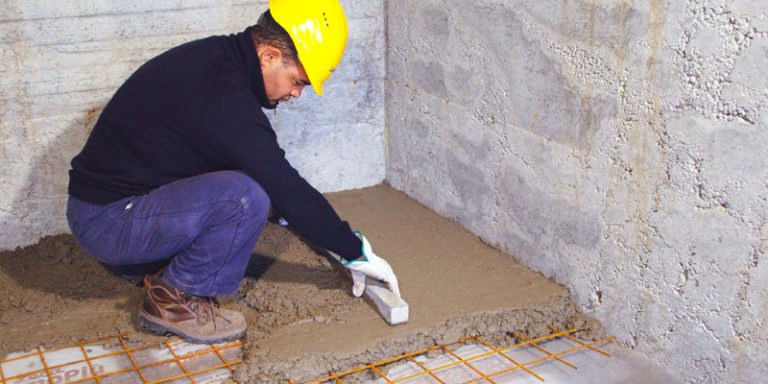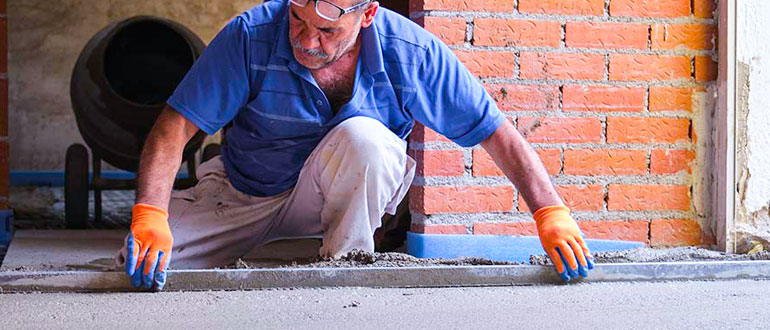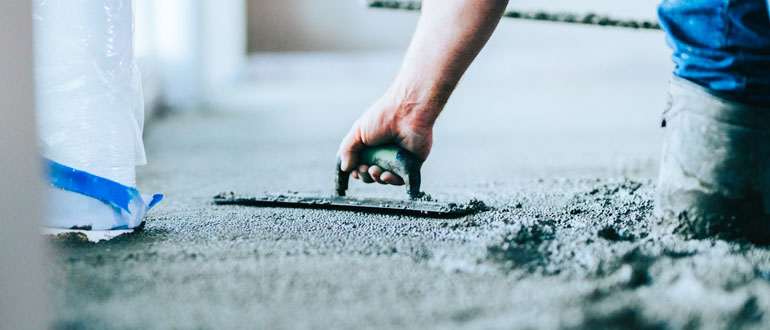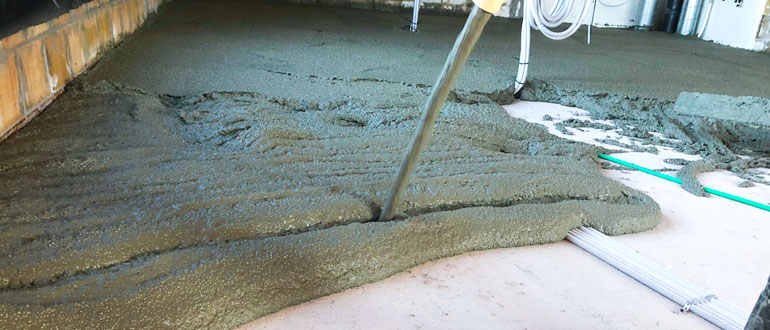Insulating a concrete floor is an important aspect of maintaining a comfortable and energy-efficient home. Whether you are looking to keep your feet warm during the cold winter months. It is crucial, how to insulate a concrete floor in your home.
Making it crucial to insulate to prevent heat loss properly. Lowering your energy bills, and insulating your concrete floor can help achieve both.
In this guide, we will explore the various materials and techniques used to insulate a concrete floor. As well as the benefits of doing so.
So, whether you are looking to create a more comfortable living room. So Reduce your carbon footprint, read on to discover how to insulate your concrete floor properly.
Gather the Necessary Tools and Supplies
Before you begin insulating your concrete floor, it’s important to gather all the necessary tools and supplies. Here are some of the items you will need:
- Measuring tape: You will need to measure the size of the space you plan to insulate so that you can purchase the correct amount of insulation material.
- Safety gear: Insulation materials can be hazardous if not handled properly, so make sure to wear gloves, a mask, and protective eyewear.
- Insulation material: Choose an appropriate insulation material based on your budget and the space you are insulating. Some popular options include fiberglass batts, foam board insulation, and spray foam insulation.
- Utility knife: A sharp utility knife will come in handy for cutting insulation material to the right size and shape.
- Adhesive: Depending on the type of insulation you choose; you may need an adhesive to secure it to the concrete floor.
- Tape measure: A tape measure will help you accurately measure and cut the insulation material.
- Caulking gun: If you are using spray foam insulation, you will need a caulking gun to apply it.
- Dustpan and brush: Cleaning up debris and excess insulation material is essential to ensure proper installation and prevent any hazards.
- Hammer and nails: You may need these tools to secure foam board insulation in place.
- Sealant: Use a sealant around the perimeter of the insulation to prevent air leakage and improve overall insulation performance.
By gathering all of these tools and supplies, you will be fully prepared to insulate your concrete floor effectively and efficiently.
The Effective Ways and Methods to Insulate a Concrete Floor
Insulating a concrete floor can be done in several ways. It depends on the type of insulation material used and the desired level of insulation. Here are some effective ways and methods to insulate a concrete floor:
- Install insulation batts: Fiberglass batts are a popular and affordable insulation option. To install them, measure and cut the batts to fit the space between the floor joists, then place them between the joists with the paper side facing up.
- Use foam board insulation: Foam board insulation is a rigid insulation material that can be cut to size and secured to the concrete floor using an adhesive. This method is effective for insulating floors above a garage or a crawlspace.
- Apply spray foam insulation: Spray foam insulation is a versatile and effective insulation option for concrete floors. It can be sprayed directly onto the concrete floor, filling any gaps and cracks, creating a continuous barrier, and preventing heat loss.
- Install radiant floor heating: Radiant floor heating is a highly efficient method of heating a concrete floor while providing insulation. The system works by circulating hot water through pipes installed in the concrete floor, which then radiates heat into the room.
- Use a vapor barrier: A vapor barrier is a sheet of material that is installed over the concrete floor before installing the insulation. It prevents moisture from entering the floor, which can help reduce mold growth and improve the overall effectiveness of the insulation.
- Seal gaps and cracks: It is important to seal any gaps or cracks in the concrete floor before installing the insulation. This will help prevent air and moisture from entering the space, which can reduce the effectiveness of the insulation.
DIY guide to insulating a concrete floor without professional help
Insulating a concrete floor can be done as a DIY project without professional help, as long as you have the necessary tools, materials, and knowledge. Here is a step-by-step DIY guide to insulating a concrete floor:
- Measure the space: Measure the size of the space you plan to insulate so that you can purchase the correct amount of insulation material.
- Clean the floor: Clean the concrete floor thoroughly, removing any debris or loose materials that may be present.
- Seal gaps and cracks: Seal any gaps or cracks in the concrete floor using a sealant. This will help prevent air and moisture from entering the space and reduce the effectiveness of the insulation.
- Choose an insulation material: Choose an appropriate insulation material based on your budget and the space you are insulating. Some popular options include fiberglass batts, foam board insulation, and spray foam insulation.
- Install insulation batts: If you use fiberglass batts, measure and cut them to fit the space between the floor joists, then place them between the joists with the paper side facing up.
- Use foam board insulation: If you use foam board insulation, cut it to size and secure it to the concrete floor using an adhesive. Make sure to cover the entire area, leaving no gaps or spaces.
- Apply spray foam insulation: If you use spray foam insulation, apply it directly onto the concrete floor, filling any gaps and cracks, creating a continuous barrier, and preventing heat loss.
- Install a vapor barrier: If desired, install a vapor barrier over the insulation material. This will prevent moisture from entering the floor and improve the overall effectiveness of the insulation.
By following these steps, you can insulate your concrete floor as a DIY project without the need for professional help.
The Best Material to Insulate a Concrete Floor
The best material to insulate a concrete floor depends on several factors, such as the level of insulation required, the budget, and the specific requirements of the space. Here are some of the most common insulation materials used for insulating a concrete floor:
- Spray foam insulation: Spray foam insulation is a popular and effective material for insulating concrete floors. It creates a seamless, airtight barrier that prevents heat loss and provides excellent thermal insulation. Spray foam insulation is a bit expensive but is long-lasting and provides excellent insulation properties.
- Foam board insulation: Foam board insulation is a rigid board made of polystyrene or polyurethane. It is relatively easy to install, lightweight, and provides good thermal insulation. Foam board insulation is an excellent choice if you’re looking for a budget-friendly option.
- Fiberglass batts: Fiberglass batts are a cost-effective option for insulating a concrete floor. They are easy to install and provide good thermal insulation. However, fiberglass batts need to be properly fitted to avoid any gaps and spaces, which can reduce their effectiveness.
- Radiant floor heating: Radiant floor heating is an effective way to insulate a concrete floor while providing a comfortable indoor temperature. It works by circulating hot water through pipes installed on the concrete floor, radiating heat into the room.
When selecting the best material to insulate your concrete floor, consider your specific requirements, budget, and level of insulation you need to achieve. All the above materials are good options for insulating a concrete floor, and the final choice should depend on the specific requirements of your space.
The Most Common FAQs
Here are some frequently asked questions (FAQs) about insulating a concrete floor:
Q: Why should I insulate my concrete floor?
A: Insulating your concrete floor can help reduce heat loss, improve energy efficiency, and increase comfort in your living space. It can also prevent moisture from seeping into the concrete, which can cause damage over time.
Q: Can I insulate a concrete floor myself?
A: Yes, you can insulate a concrete floor yourself. However, it requires some knowledge and experience to choose the right materials and install them correctly. You should also follow all safety precautions when handling insulation materials.
Q: What is the best insulation material for a concrete floor?
A: The best insulation material for a concrete floor depends on several factors, such as the level of insulation required, the budget, and the specific requirements of the space. Common options include spray foam insulation, foam board insulation, fiberglass batts, and radiant floor heating.
Q: How much insulation do I need for my concrete floor?
A: The amount of insulation you need for your concrete floor depends on the size of the space, the type of insulation material used, and the desired level of insulation. Measure the area carefully and consult an insulation professional or manufacturer for specific recommendations.
Q: How do I install insulation on a concrete floor?
A: The installation process for insulation on a concrete floor can vary depending on the type of insulation material used. Generally, the process involves cleaning the floor, sealing gaps and cracks, installing insulation material, and covering it with a vapor barrier. Consult the manufacturer’s instructions or seek professional help for more detailed guidance.
Q: How much will it cost to insulate my concrete floor?
A: The cost of insulating a concrete floor depends on various factors, such as the type of insulation material used, the size of the space, and the complexity of the installation. Consult with an insulation professional or manufacturer for specific estimates.
Conclusion
Insulating a concrete floor is an effective way to reduce heat loss, increase energy efficiency, and improve the overall comfort of your living space. By choosing the right insulation material and installing it correctly, you can achieve significant energy savings and make your home more comfortable.
While insulating a concrete floor can be a DIY project, it’s important to have the necessary knowledge and experience to ensure a successful installation. You should also follow all safety precautions when handling insulation materials.
Overall, insulating a concrete floor is a worthwhile investment that can save you money on energy bills and improve the comfort of your living space. Consult with an insulation professional or manufacturer for specific recommendations and instructions on how to insulate your concrete floor.



